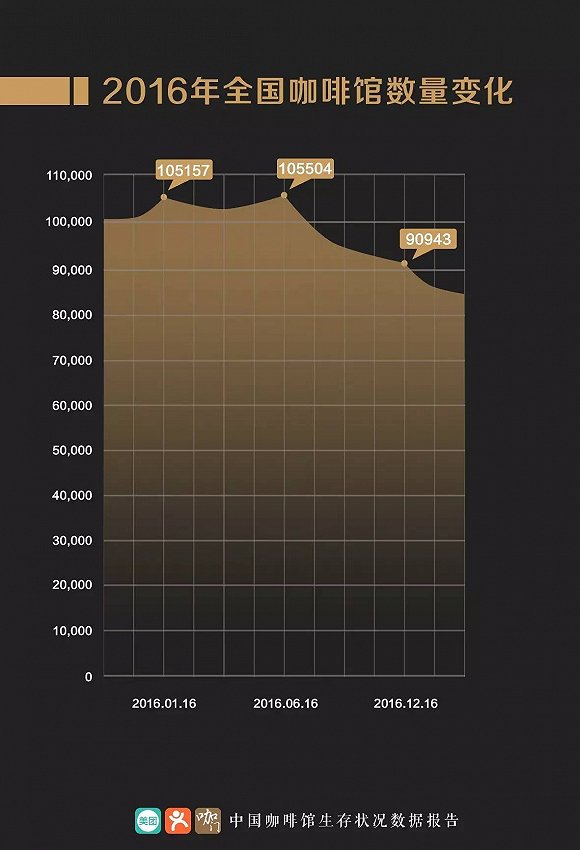How many cafes are there in China? What's the living condition?
In the era of experience consumption, today, when the customer group is younger and iterative, there has never been a new category, which is so favored by young people. It is not only a symbol, a culture, but also a new industry full of vitality. Its consumer market is growing at an annual rate of 16%, several times the world average.
It's all too fast.
Today, "Ka Men" and "Meituan Dianping Research Institute" launched the first issue of beverage industry data report. The number of cafes in China exceeded 100000 in 2016, according to the report.
This is the worst time for coffee, this is the best time for coffee.
In the era of experience consumption, today, when the customer group is younger and iterative, there has never been a new category, which is so favored by young people. It is not only a symbol, a culture, but also a new industry full of vitality. Its consumer market is growing at an annual rate of 16%, several times the world average.
But at the same time, the coffee market development stage upside down, the new customer group portrait particularity, as well as the new technology iteration and impact. In this vast land with complex consumption habits, as a kind of parked product, coffee has never encountered such an unbalanced and rapidly iterative market ecology.
Fierce competition, increased shuffling speed, easy to open a shop and difficult to make money have become the common feelings of coffee shop owners.
At a time when the industry is surging and changing, we hope to provide some reliable tools for the industry.
From now on, "Ka Men" and "Meituan Dianping Research Institute" have initiated the establishment of the "Beverage big data Center" and regularly launched the industry big data.
The first issue of the industry big data report is about the current situation of cafes in China. You will see:
@ how many peers are competing on the industry track? Which track are you on?
@ what changes are taking place in the pattern of the coffee industry?
@ what is the migration of consumers in the new era? Is it consistent with your customer group?
@ what are the opportunities to break through in terms of products, environment and services under the cover of the giants of the industry?
Data sampling description: the data are extracted from three time nodes on Meituan Dianping: January 15, June 15, 2016 and December 15, 2016. coffee data from four first-tier cities of Beijing, Shanghai, Guangzhou and Shenzhen and 12 key cities of Tianjin, Chongqing, Shenyang, Nanjing, Wuhan, Chengdu, Xi'an, Hangzhou, Qingdao, Zhengzhou, Xiamen and Dalian.
Some of the macro data are published by the International Coffee Organization and the National Bureau of Statistics.
one
Cafe explosion:
The number exceeded 100000, and the industry reshuffle intensified.
one
Cafe "explosion"
The number of cafes nationwide exceeded 10W, with negative growth for the whole of 2016, and a new round of reshuffle appeared in the industry in the second half of the year.

▲ grew slightly in the middle of the year, and industry reshuffle appeared in the second half of the year.
Conclusion
The number of cafes increased slightly in the middle of the year in 2016, but the net closure rate for the whole year was relatively high, reaching 13.5%.
The change in the number of cafes is parabolic, with a small annual growth, and a new round of reshuffle will be carried out in the industry in the second half of the year.
Cause analysis
1) the foundation of coffee market is weak
2) non-business-driven individual entrepreneurs who ignore the basic skills of business
3) mismatch between supply and demand in market segments
Important Notice :
前街咖啡 FrontStreet Coffee has moved to new addredd:
FrontStreet Coffee Address: 315,Donghua East Road,GuangZhou
Tel:020 38364473
- Prev

Drifting Book Cafe "unveiled Coffee Street" Xiamen citizens can "Book rafting"
Yesterday, to Xidi Coffee Street, it is not difficult for the public to find that there are four different shapes of book cafes, but also to achieve book drifting. On the afternoon of April 22nd, drifting Book Cafe was officially opened at the launching ceremony of the Chinese style 2017 Siming International Community Charity Culture Festival. As long as you leave a book, you can take away a book. Chinese and foreign friends can share good books together and experience book delivery.
- Next

How many cafes are there in China? What's the living condition? (2)
Coffee shop cities rank Shanghai has the largest number of cafes, the lowest closure rate, the highest level of operation ▲ 16 cities coffee shop quantity changes ▲ 16 city coffee shop ranking data analysis 1) the 16 cities extracted from the data showed negative growth, with an average closure rate as high as 14.1%; 2) the lowest decline was 3.0% in Shanghai, 25.4% in Chengdu and 14.7% in Beijing. 3) Beishangguang
Related
- What documents do you need to go through to open a coffee shop? coffee shop coffee shop certificate processing process
- How to purchase Coffee beans in small Cafe how to choose a suitable supplier for domestic Coffee supply Company
- How to drink Starbucks Fragrance White Coffee? how to make Australian White Coffee? what Italian coffee beans are recommended?
- The Story of Flora Coffee: the name of Flora Coffee Bean and the implication of the Flowers on Florna Coffee
- How much does a cup of coffee cost? How much is the profit of a cup of coffee? What is the profit of the coffee shop in a year?
- Yunnan small Coffee, known as "fragrant Coffee", introduces the characteristics of Alpine Arabica Coffee producing areas in Yunnan, China
- 2023 latest Starbucks full menu price list how much is a cup of Starbucks coffee what is better to drink the most popular hot and cold drinks recommended
- Starbucks different kinds of Coffee Price list Starbucks menu 2023 Top Ten Best drinks in Starbucks
- Starbucks Spring praise Comprehensive matching Coffee Bean theme Story Packaging implication and taste description
- The cost of a cup of coffee latte American coffee cost price and selling price

